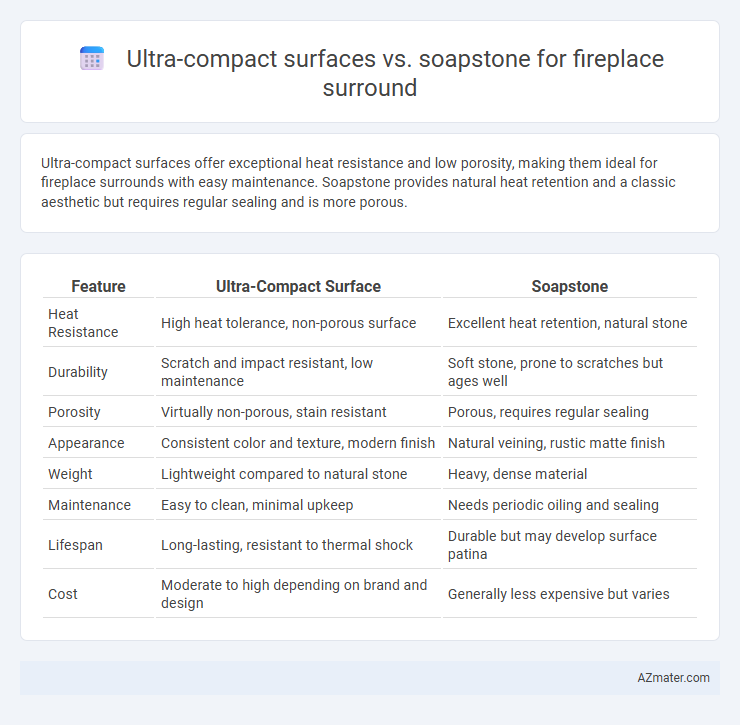Ultra-compact surfaces offer exceptional heat resistance and low porosity, making them ideal for fireplace surrounds with easy maintenance. Soapstone provides natural heat retention and a classic aesthetic but requires regular sealing and is more porous.
Table of Comparison
| Feature | Ultra-Compact Surface | Soapstone |
|---|---|---|
| Heat Resistance | High heat tolerance, non-porous surface | Excellent heat retention, natural stone |
| Durability | Scratch and impact resistant, low maintenance | Soft stone, prone to scratches but ages well |
| Porosity | Virtually non-porous, stain resistant | Porous, requires regular sealing |
| Appearance | Consistent color and texture, modern finish | Natural veining, rustic matte finish |
| Weight | Lightweight compared to natural stone | Heavy, dense material |
| Maintenance | Easy to clean, minimal upkeep | Needs periodic oiling and sealing |
| Lifespan | Long-lasting, resistant to thermal shock | Durable but may develop surface patina |
| Cost | Moderate to high depending on brand and design | Generally less expensive but varies |
Introduction to Fireplace Surround Materials
Ultra-compact surfaces are engineered materials known for exceptional durability, heat resistance, and low porosity, making them ideal for modern fireplace surrounds requiring minimal maintenance and sleek aesthetics. Soapstone, a natural metamorphic rock, offers high heat retention and a soft, natural texture with excellent thermal conductivity, which allows it to radiate warmth long after the fire has died down. Both materials provide unique benefits for fireplace surrounds, with ultra-compact surfaces favoring contemporary design and soapstone emphasizing natural beauty and heat efficiency.
What Is Ultra-Compact Surface?
Ultra-compact surface is an engineered material composed of natural minerals, compressed at extremely high pressure to create a dense, durable slab ideal for fireplace surrounds. It boasts high resistance to heat, scratches, and stains, outperforming traditional materials like soapstone in durability and maintenance. Unlike soapstone, ultra-compact surfaces offer a broader range of colors and patterns, providing enhanced versatility and modern aesthetic appeal.
Properties of Ultra-Compact Surface for Fireplaces
Ultra-compact surfaces offer exceptional heat resistance and durability, making them ideal for fireplace surrounds where high temperatures are frequent. Their non-porous structure resists stains and moisture, ensuring easy maintenance and long-lasting aesthetics compared to soapstone, which requires regular sealing. These surfaces also provide superior scratch resistance and a wide range of design options, enhancing both functionality and style in fireplace installations.
Overview of Soapstone as a Fireplace Surround
Soapstone is a natural metamorphic rock known for its exceptional heat retention and slow heat release, making it ideal for fireplace surrounds. Its dense composition resists cracking and thermal shock, ensuring durability and longevity in high-temperature environments. Beyond functionality, soapstone offers a unique, smooth texture and rich, natural variation in color that enhances the aesthetic appeal of any fireplace design.
Heat Resistance: Ultra-Compact Surface vs Soapstone
Ultra-compact surface materials exhibit exceptional heat resistance, often withstanding temperatures up to 1200degF (650degC) without cracking or discoloration, making them ideal for fireplace surrounds. Soapstone, known for its natural density and heat-retaining properties, also offers high heat resistance but may be more susceptible to scratching and requires periodic maintenance to preserve its integrity. Both materials efficiently dissipate heat, but ultra-compact surfaces provide superior durability and color stability under extreme thermal conditions.
Aesthetic Appeal and Design Versatility
Ultra-compact surfaces offer a sleek, modern aesthetic with a consistent pattern and a wide range of colors and finishes, enhancing design versatility for fireplace surrounds in contemporary interiors. Soapstone provides a natural, rustic charm with unique veining and a matte finish that deepens in color over time, ideal for traditional or cozy settings. Both materials withstand heat well, but ultra-compact surfaces allow for greater customization in size and shape, enabling intricate designs and seamless installations.
Maintenance and Durability Comparison
Ultra-compact surfaces offer exceptional durability with high resistance to scratches, stains, and heat, making them ideal for fireplace surrounds requiring low maintenance and long-lasting performance. Soapstone, known for its natural heat retention and resistance to cracking, requires regular oiling to maintain its appearance and prevent surface dryness, which involves more maintenance compared to ultra-compact surfaces. While both materials withstand high temperatures, ultra-compact surfaces provide a more resilient and easier-to-clean option, whereas soapstone offers a unique, natural aging process that demands consistent upkeep.
Installation Requirements and Considerations
Ultra-compact surfaces require minimal substrate preparation and can be installed directly over existing fireplace surrounds due to their lightweight, thin profile, and high resistance to heat and scratches. Soapstone demands proper structural support because of its substantial weight and thickness, along with careful sealing to prevent staining and maintain its heat-resistant properties. Installation of soapstone is labor-intensive, often requiring skilled masons to ensure precise fitting and secure mounting, whereas ultra-compact materials allow for faster, more straightforward application with standard tile adhesives.
Cost Comparison: Ultra-Compact Surface vs Soapstone
Ultra-compact surfaces generally cost between $50 and $100 per square foot, offering a modern, durable, and low-maintenance option for fireplace surrounds. Soapstone ranges from $70 to $120 per square foot, valued for its natural heat retention and unique veining but requires more maintenance and occasional sealing. Cost efficiency favors ultra-compact surfaces for budget-conscious projects, while soapstone provides long-term thermal benefits despite a higher initial investment.
Which Material Is Right for Your Fireplace Surround?
Ultra-compact surfaces offer exceptional durability, resistance to heat, scratches, and stains, making them highly suitable for fireplace surrounds requiring low maintenance and modern aesthetics. Soapstone provides excellent heat retention and natural beauty with its warm, smooth texture, ideal for traditional or rustic designs but demands regular sealing to maintain its appearance. Choosing between ultra-compact surfaces and soapstone depends on your priorities for heat performance, maintenance, and style preference in your fireplace surround.

Infographic: Ultra-compact surface vs Soapstone for Fireplace surround
 azmater.com
azmater.com